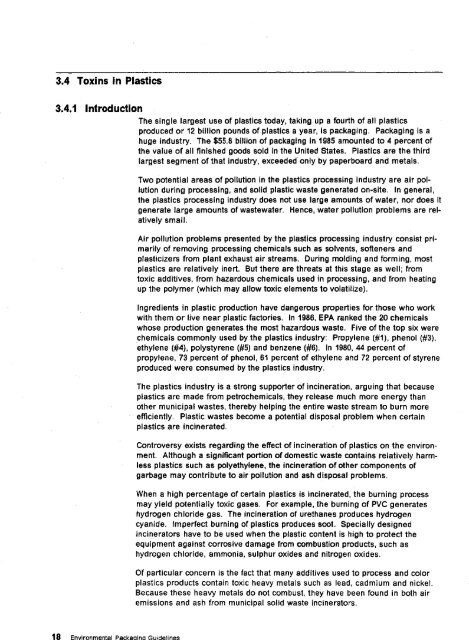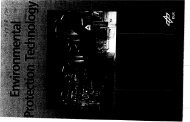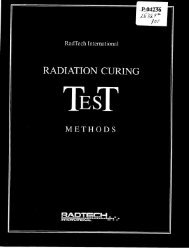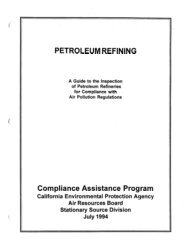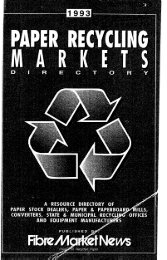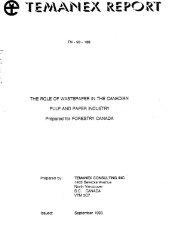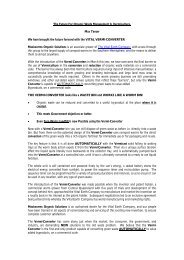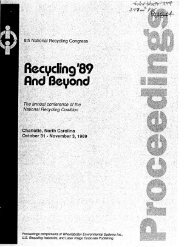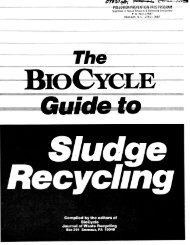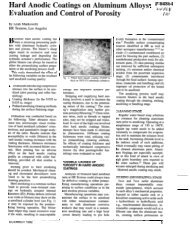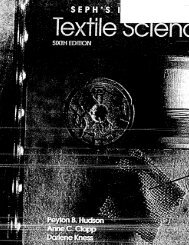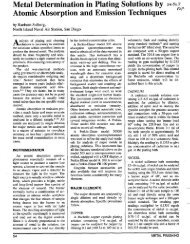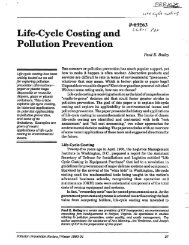Electronic Parts/Guidelines - infoHouse
Electronic Parts/Guidelines - infoHouse
Electronic Parts/Guidelines - infoHouse
You also want an ePaper? Increase the reach of your titles
YUMPU automatically turns print PDFs into web optimized ePapers that Google loves.
3.4 Toxins in Plastics<br />
3.4.1 Introduction<br />
The single largest use of plastics today, taking up a fourth of all plastics<br />
produced or 12 billion pounds of plastics a year, is packaging. Packaging is a<br />
huge industry. The $55.8 billion of packaging in 1985 amounted to 4 percent of<br />
the value of all finished goods sold in the United States. Plastics are the third<br />
largest segment of that industry, exceeded' only by paperboard and metals.<br />
18 Environmental Packaolno <strong>Guidelines</strong><br />
Two potential areas of pollution in the plastics processing industry are air pol-<br />
lution during processing, and solid plastic waste generated on-site. In general,<br />
the plastics processing industry does not use large amounts of water, nor does it<br />
generate large amounts of wastewater. Hence, water pollution problems are rel-<br />
atively small.<br />
Air pollution problems presented by the plastics processing industry consist pri-<br />
marily of removing processing chemicals such as solvents, sofleners and<br />
plasticizers from plant exhaust air streams. During molding and forming, most<br />
plastics are relatively inert. But there are threats at this stage as well; from<br />
toxic additives, from hazardous chemicals used in processing, and from heating<br />
up the polymer (which may allow toxic elements to volatilize).<br />
Ingredients in plastic production have dangerous properties for those who work<br />
with them or live near plastic factories. In 1986, EPA ranked the 20 chemicals<br />
whose production generates the most hazardous waste. Five of the top six were<br />
chemicals commonly used by the plastics industry: Propylene (#I), phenol (#3),<br />
ethylene (#4), polystyrene (#5) and benzene (#6). In 1980, 44 percent of<br />
propylene, 73 percent of phenol, 61 percent of ethylene and 72 percent of styrene<br />
produced were consumed by the plastics industry.<br />
The plastics industry is a strong supporter of incineration, arguing that because<br />
plastics are made from petrochemicals, they release much more energy than<br />
other municipal wastes, thereby helping the entire waste stream to burn more<br />
efficiently. Plastic wastes become a potential disposal problem when certain<br />
plastics are incinerated.<br />
Controversy exists regarding the effect of incineration of plastics on the environ-<br />
ment. Although a significant portion of domestic waste contains relatively harm-<br />
less plastics such as polyethylene, the incineration of other components of<br />
garbage may contribute to air pollution and ash disposal problems.<br />
When a high percentage of certain plastics is incinerated, the burning process<br />
may yield potentially toxic gases. For example, the burning of PVC generates<br />
hydrogen chloride gas. The incineration of urethanes produces hydrogen<br />
cyanide. Imperfect burning of plastics produces soot. Specially designed<br />
incinerators have to be used when the plastic content is high to protect the<br />
equipment against corrosive damage from combustion products, such as<br />
hydrogen chloride, ammonia, sulphur oxides and nitrogen oxides.<br />
Of particular concern is the fact that many additives used to process and color<br />
plastics products contain toxic heavy metals such as lead, cadmium and nickel.<br />
Because these heavy metals do not combust, they have been found in both air<br />
emissions and ash from municipal solid waste incinerators.


